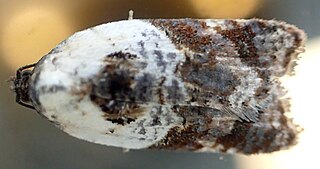
Acleris variegana, the garden rose tortricid moth or fruit tortricid, is a moth of the family Tortricidae. It has a Palearctic distribution. The moth flies from July to September mainly at night and is attracted to bright lights. The larvae feed on various trees and shrubs including rose and apple.

Archips podana, the large fruit-tree tortrix, is a moth of the family Tortricidae. The species was first described by Giovanni Antonio Scopoli in his 1763 Entomologia Carniolica. It is found in Europe, Asia from Anatolia to Japan and is an introduced species in North America.

Archips xylosteana, the variegated golden tortrix or brown oak tortrix, is a moth of the family Tortricidae.

Crocidosema plebejana, the cotton tipworm, is a tortrix moth, belonging to tribe Eucosmini of subfamily Olethreutinae. It is found today all over the subtropical and tropical regions of the world and even occurs on many oceanic islands – in Polynesia and Saint Helena for example – but has probably been accidentally introduced to much of its current range by humans. In addition, it is also found in some cooler regions, e.g. in Europe except in the east and north; this is probably also not natural, as it was, for example, not recorded in the British Isles before 1900.
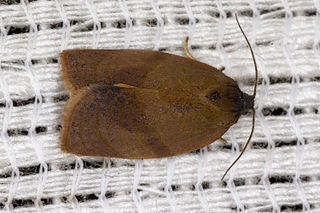
Cacoecimorpha is a monotypic moth genus of the family Tortricidae. Cacoecimorpha pronubana—the carnation tortrix—is its sole species and is found in Europe, northern Africa, South Africa, Anatolia and North America.

Bactra is a genus of moths belonging to the subfamily Olethreutinae of the family Tortricidae.

Cochylimorpha is a genus of moths of the family Tortricidae.
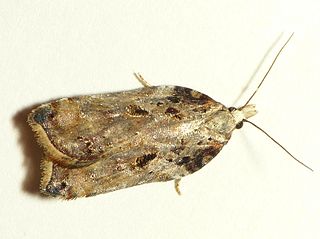
Acleris cristana, the rufous-margined button moth, is a moth of the family Tortricidae and is found from Europe through the Caucasus and Ussuri to Japan.
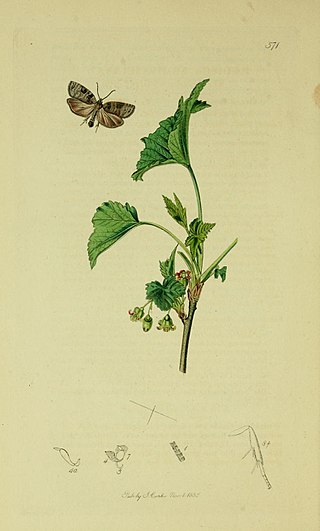
Apotomis semifasciana, the short-barred grey marble, is a moth of the family Tortricidae. It was first described by the English entomologist Adrian Hardy Haworth in 1811.

Bactra venosana, the nutgrass borer or nutsedge borer, is a moth of the family Tortricidae. It was first described by Philipp Christoph Zeller in 1847. Julius von Kennel provides a full description. It has a wide distribution, from southern Europe, North Africa and Asia Minor to India, Sri Lanka, southern China, Malaya, Australia and into the Pacific where it is found on Java, Borneo, the Philippines, Taiwan, Timor, the Solomons, the Carolines and Fiji. It was introduced to Hawaii in 1925 to control nutsedge. It is now found on Kauai, Oahu, Molokai, Maui, Lanai and Hawaii.

Acleris ferrugana is a species of moth of the family Tortricidae. It is found in China, most of Europe and has also been recorded from North America.

Ancylis mitterbacheriana is a species of moth of the family Tortricidae. It is found in most of Europe, except the Iberian Peninsula, most of the Balkan Peninsula and Ukraine.
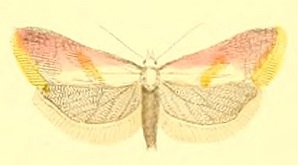
Cochylis flaviciliana, the gold-fringed conch, is a moth of the family Tortricidae. It was described by Westwood in 1854. It is found in most of Europe and north-western Africa. The habitat consists of chalky grasslands.

Bactra bactrana is a species of moth of the family Tortricidae. It is found on the Canary Islands, Sicily and Malta and in southern Spain, Portugal, southern Italy, France, Greece, Morocco, Algeria, Egypt, Asia Minor, Arabia, Iraq, Iran, the Caucasus, Afghanistan, the Caspian area, Tajikistan, Kyrgyzstan, Uzbekistan, Pakistan, India, the Republic of Congo, Madagascar, Sudan and Gambia.

Bactra furfurana, the mottled marble, is a moth of the family Tortricidae described by Adrian Hardy Haworth in 1811. It is found in the Nearctic and Palearctic realms.
Bactra lacteana is a moth belonging to the family Tortricidae first described by Aristide Caradja in 1916.

Bactra suedana is a moth, belonging to the family Tortricidae. The species was first described by Bengt Å. Bengtsson in 1989.

Eucosma fulvana is a species of moth, belonging to the genus Eucosma.

Ancylis unguicella is a moth belonging to the family Tortricidae. The species was first described by Carl Linnaeus in his landmark 1758 10th edition of Systema Naturae.
Epiblema angulatana is a moth belonging to the family Tortricidae. The species was first described by Julius von Kennel in 1901.



















